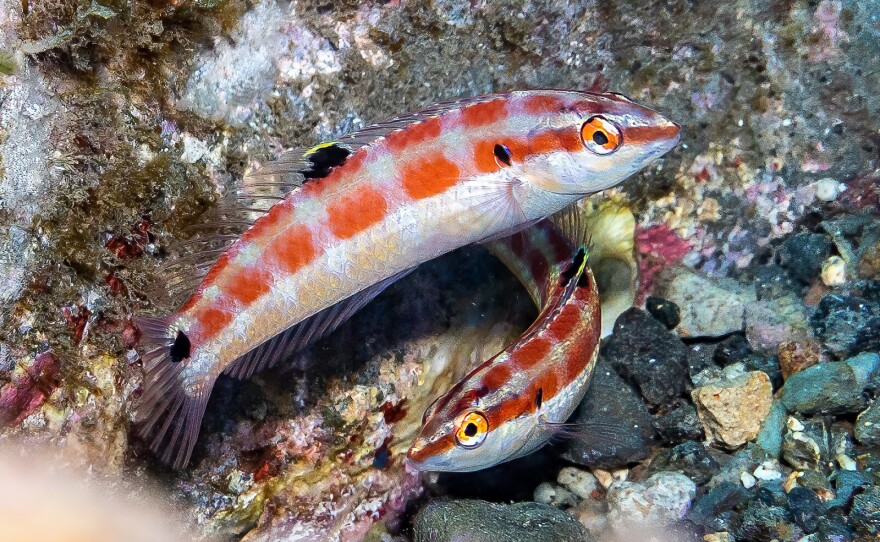A team of scientists including Ben Frable of UC San Diego's Scripps Institution of Oceanography discovered a new species of tropical fish during an expedition to remote Mexican islands, it was announced Wednesday.
The fish, named the Halichoeres sanchezi or the tailspot wrasse, likely only lives on the rugged Revillagigedo Archipelago off Mexico's Pacific coast. The volcanic island chain is sometimes referred to as the "Mexican Galapagos" for its endemic biodiversity — meaning organisms that are native and restricted to a certain place.
Frable and other scientists published a paper naming the fish in the journal PeerJ.
Halichoeres sanchezi was named in honor of marine scientist Carlos Armando Sánchez Ortíz of the Universidad Autónoma de Baja California Sur, who collected the first specimen and organized the 2022 expedition that led to the fish's discovery.
"Characterizing and naming a species previously unknown to science feels like you've made a mark on history," Frable told City News Service. "This name will hopefully stay with the species as long as we use taxonomic names. This is the ninth fish I have helped describe, but it is the first where I was one of the first scientists to encounter the species in the wild."
Frable said naming a new species is up to the people discovering it, "but there are actually some internationally agreed upon rules and guidelines called the International Code of Zoological Nomenclature to help standardize it."
"Names need to be conjugated into Latin and are generally derived from Ancient Greek or Latin words, but this is not required," he said. "The big rule is that you cannot name species after yourself. You can certainly name them in honor of other people, such as this fish."
The team collected eight specimens of the fish, ranging in size from around one inch long to nearly six inches. The females of the species are mostly white with reddish horizontal stripes along their top half and black patches on their dorsal fin, behind their gills, and just ahead of their tail fin, a statement from Scripps read. Frable described the males as "orangey red up top fading to a yellow belly with a dark band at the base of the tail."
Halichoeres sanchezi is a member of the wrasse family, a diverse and colorful group of more than 600 species.
According to a statement from UCSD, researchers encountered the new species inhabiting an underwater field of volcanic rubble at a depth of around 70 feet near San Benedicto Island — one of four islands in the Revillagigedo Archipelago. The island chain is a marine protected area located around 250 miles to the south of the Baja California peninsula and some 500 miles west of mainland Mexico's coastline.
"The main way to access the area is via live-aboard one-week scuba diving tours," Frable told CNS. "The islands are mostly uninhabited except for Mexican military outposts, so you generally cannot venture onto land, but you can experience the amazing aquatic world around them. They are a national park and a UNESCO World Heritage Site."
The islands' remote location and legal protections have made it difficult to study the undersea fauna. The last scientific assessment of the islands' fishes occurred more than two decades ago.
Over the course of roughly two weeks, the group surveyed all four islands during 30 research dives that produced more than 5,500 photographs and 900 specimens representing more than 100 fish species.
"One thing most people don't realize, including myself before working in taxonomy, is how often previous unknown species are being named and reported," Frable said. "For fishes alone, 300-500 new species are described every year. But a lot of these are recognized after they are collected from museum collections or other places.
"The process of describing and naming a species can be time-consuming and requires attention to detail," he said.
The specimens collected are stored in Scripps' Marine Vertebrate Collection, Mexico's Colección Nacional de Peces and the Natural History Museum of Los Angeles County.
According to the researchers, the wrasse wasn't spotted until the last day of the expedition. An unknown fish had been photographed in 2013 but never identified. Sánchez was able to collect a mysterious red fish that only later the team realized matched the wrasse in the photo.
However, they had collected a female, an important distinction for the wrasse family — of which many are sequential hermaphrodites, all beginning life as female and later transitioning to male if the right conditions come about.
On the second to last dive of the expedition Frable spotted the "terminal phase" — or male — of this unknown wrasse species, but was unable to catch it. Finally, on the very last dive of the trip, William Ludt, co- author of the study and assistant curator of ichthyology at the Natural History Museum of Los Angeles County, and Frable were able to collect an example of the species' terminal phase.
In all, the researchers collected eight specimens of the fish. Later DNA analysis revealed the genetic divergence from close relatives — the golden wrasse from Panama and red-striped wrasse from Cocos Island near Costa Rica.
Frable said more trips to the archipelago were likely on the way, with the team hoping to unravel the mystery of the islands' unique biodiversity.






